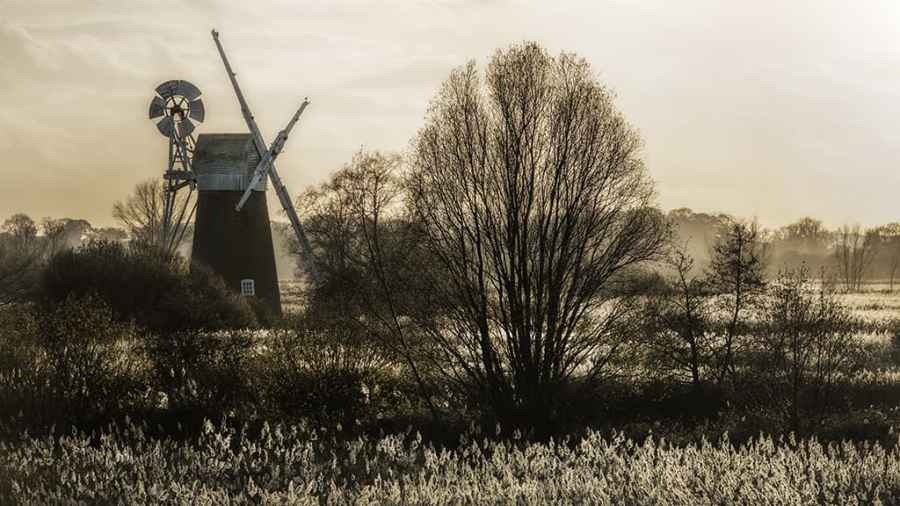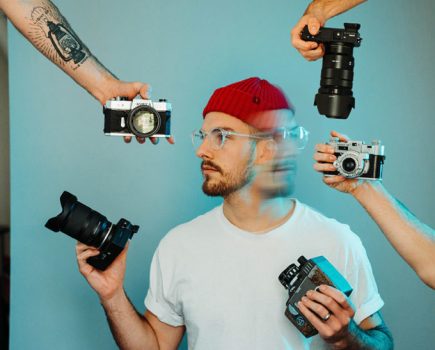
Your guide: Jeremy Walker – Jeremy is regarded as one of the finest landscape photographers in the UK and has been producing eye-catching images for use by clients around the globe for over 25 years. He is in regular demand as a guest speaker, writer and workshop leader and wrote the book, Landscape. See his website for more.
Why do we do it?
What is it that compels us to set the alarm to some unearthly hour, hang around in the pre-dawn cold, damp and dark, just for the fleeting possibility of taking a photograph which may or may not be any good? Shooting landscapes requires a certain mindset.
Why might we drive long distances to some far-flung location in the vain hope of taking a picture? Are the miles spent on the motorways, highways and byways, and the short sleepless nights in uncomfortable hotels really worth it just to produce a landscape image? Why do we do it?!
As a working professional I could answer all such questions with the fact that it’s my job; but that would be an unsatisfactory answer, and an unsatisfying job. There is more to it than a living – it is more a way of life.

For many it could be as simple as just enjoying the great outdoors, the exercise and the fresh air, but this does not explain the drive to get up early, carry a camera, or hang around for a sunset. Is it the solitude, peace and quiet of the countryside that draws us in, or is it the desire to be creative?
A colleague of mine (a very well-known American photographer) described going out location hunting and shooting a landscape as being on a treasure hunt; the search for the location being an important part of the journey, as important as shooting the final image.

Perhaps for many landscape professionals it is a lifestyle choice, the joy of travelling and new experiences, staying in hotels, eating out, meeting the locals, exploring new destinations and hunting for a location or viewpoint that hopefully no one has shot before. In the past you could make a living doing this.
Before you say, ‘What a great life,’ there are many downsides too. Being away from home for weeks or months at a time puts immense strain on family life, and I know many professional photographers with failed marriages. The cost of travelling and shooting can mount up very quickly, especially if your plans start to unravel.
I have spent seven nights in one hotel in the hope it would stop raining long enough for me to shoot one landscape. The costs rapidly mounted and then there was the added pressure to make up for lost time at the next location. It is a great life when it all comes together but needs to be carefully balanced between financial reward, lifestyle and family.

What of enthusiasts who have ‘proper’ jobs, with normal financial constraints and family commitments? It is surely harder for them to justify spending all their time shooting, travelling or researching landscapes. What drives them to such lengths? An enjoyment and passion for creating landscape images, for being outdoors and enjoying Mother Nature, no doubt. In this day and age, though, I suspect some people will have other motives besides.
There will be some who shoot landscapes purely for their ego and the adulation, to gain more ‘likes’ on their social media posts than the next person – who seek validation from others to feel some arbitrary respect for themselves.
Many will shoot landscapes because they see it as a way of adding to their income through the use of stock agencies. Others will shoot landscapes because it is part of an ongoing project, a book, competition entry or qualification panel. Most of us, however – pros and enthusiasts alike – just want to go and shoot images that fulfil our creative desire and passion.
Where do we go?
So where do you go to shoot your landscapes and what makes you want to shoot a particular location? How do you find that location? Again, landscape locations, like so many aspects of photography, come down to personal choice.
Some photographers will want to shoot coastal scenes, others snow-capped mountains, and there will be those working to strictly defined parameters to suit the project they are working on. Others of course are happy to go with the flow, drift and shoot whatever they stumble upon.
Years ago, location finding was every bit an art form as the actual image taking was. There were no social media platforms displaying thousands of oversaturated, annotated, geo-tagged, pinned and cross-referenced images. There were very few location guidebooks – travel guides, yes, but books written solely to show photographers the coordinates of where to put their tripods: no.

My American friend was right: location finding was akin to a treasure hunt, and hopefully you were the first to the treasure. Nowadays, with the plethora of media platforms displaying the latest images from around the world on a daily basis most photographers will have an idea of where they want to go.
But here’s a thing, do you go and just copy what has been done before, or take inspiration from an image you have seen and use this as the basis for your own exploration? I know many enthusiasts simply do not have the time for hours of research and time on location is a precious resource; but try not to blatantly copy someone else’s shot.
Be inspired and stimulated by others but have the courage of your own convictions to do things your own way. The alternative will be to queue up with all the other photographers to shoot ‘the’ waterfall, mountain, castle etc from exactly the same spot as everyone else.
Workshops are a great way to shoot locations if your time is precious. You will be delivered to the right spot at the correct time, the legwork of location hunting being taken away from you. The downside, of course, is the potential for the rest of the group to shoot a very similar image to yours.
I have to admit I enjoy shooting on my own, researching locations and doing a little exploring and not telling anyone where I have been, happily spending hours in my own company to produce a single image. However, not everybody is as intrepid on their own, and understandably so.

If you are with a fellow photographer, try not to stand side by side, tripods overlapping, taking exactly the same shot. We have all been influenced, stimulated and hopefully motivated by other photographers’ work at one time or another and this is only healthy.
Just try to avoid outright copying; put your own take on any given landscape location. After all, a location should be more than just a set of coordinates and a ticked box.
When is the best time?
Most people who shoot landscapes will have it in their heads that the best time to shoot is at sunrise and sunset. As a very general rule this could said to be true. However, there is plenty to a landscape in between those times – more than a pretty pink sky at sunrise or fiery orange clouds at sunset.
Think about the quality of light, its direction, strength and colour. I see many people shooting sunsets and totally ignoring the gorgeous light hitting the landscape and ignoring it’s potential. Look for how it is interacting and playing across the surface of the scene to give an effect and a look far greater than just another shot of orange clouds.
Again, it comes down to the individual’s taste and how we see the world, but try to look beyond the obvious. Perhaps set yourself the task of shooting a series of landscapes where you don’t actually look directly at the sunrise or sunset; observe what the light actually does.
The light before sunrise, often muted and pastel in colour and low in contrast can be quite exquisite, but is so often overlooked. The same can be said of the light at the end of the day. With everyone’s obsession with the actual sunset, the light an hour or so before the sun dips over the horizon can be fantastically sharp, directional, colourful and very usable.
Thirty minutes or so after a sunset, you again can have a great quality to the light. Landscape photography is not about sunrise and sunset, it’s about the light and using it to maximum effect. Landscape photography should not be limited to just the dawn and dusk sessions with which we associate it.
Long shadows and oodles of texture created by a low sun are great, yet given the right subject matter and appropriate weather you can shoot at pretty much any time of day. Start thinking about the light and how it behaves, how it interacts with the landscapes around you. Free up your creative mind and get away from just the sunrise/sunset approach.

What kit do you need?
Carrying a camera and lenses to do the job in hand should be a simple enough procedure. If you have done the appropriate research and know where you are going and what type of shot you are after, you can whittle the amount of camera gear you are carrying down to a minimum.
Overloading your bag with too much kit could turn a potentially enjoyable exploration of a stunning location into a yomp of pain and discomfort. I am reminded of a photographer who carried two bodies, a 16-35mm, 24-70mm and 70-200mm zooms, five spare batteries, a flash gun and large tripod to his location.
And this was before he had to pack waterproofs, water bottle and other sundry items that were needed. Needless to say, he didn’t enjoy himself and refused to admit he was carrying too much.
I know there is a great fear with enthusiasts that they will miss out on the shot of a lifetime if they are not carrying every bit of kit they own, but I feel there is also an equal opportunity to miss out because you are not enjoying yourself, your head is constantly facing the ground, your back hurts and everything has become a burden.
Take a small gamble, rationalise what kit you may need for a given location and keep things to a minimum. During the course of shooting my book, Landscape, I started to walk into locations with a Leica M10 body and three small primes. Having a minimal
amount of kit at my disposal really helped to concentrate the mind, made me work really hard for angles and viewpoints that worked and, just as importantly, the walk in to the location was much more pleasurable.
In fact, the whole shooting experience was so much nicer. Yes, there is of course the chance that you may miss a shot, but you cannot legislate for every conceivable scenario when on location, unless of course you are shooting a commissioned job and the budget allows for a Sherpa.
What is ‘minimal’ kit?
The minimum kit for a landscape location shoot is probably a body with a 24-70mm zoom, a spare battery, a handful of LEE Filters and a tripod. But do you think about the ‘other’ stuff?
Waterproofs and an additional warm layer, plus a hat and gloves, especially if you are at altitude or shooting in winter. How about a map? Apps don’t always work in remote areas and battery strength can be limited in the cold.
A water bottle is a must, even for short walks; and if you are staying out longer, a flask with a hot beverage could be essential. High-energy snacks should be carried on longer walks and, if heading out on to the mountains in winter, a survival bag.
Have you thought also about carrying a small first aid kit, a whistle and a head torch, and do you know the internationally recognised distress signal, and – just as importantly – the correct response? Now, you may think I am being over the top and that you are never going to be too far from the car.
Here’s a thing. Many people have walked up to and shot The Old Man of Storr, on the Isle of Skye. A popular location with landscapers, about an hour and a half’s steepish walk from the car park. Clear and sunny when you start out, you warm up, you drink water. At the top you are waiting for the light, it clouds up and the wind starts to blow.
Your body has cooled rapidly, you add the extra layer you are carrying and have a slurp of coffee. Hopefully you are okay. You are prepared, you have not only your camera kit but the right kit for just being at that location. It means you can shoot and be safe. Location photography is not about carrying all your camera kit: carry the right kit and be able to enjoy yourself.
Jeremy’s 8 top tip for great landscapes
1. Consider the location
How it will work with the final image you have in your mind. Does it tell a story, convey a message or is it just a record shot with a pretty pink sky? Try to avoid the bland and banal, and think for yourself.
Have the courage to stick to your own creative thoughts and ideas.
2. Shoot locations you want to shoot
Explore, study maps and head a little off the beaten track. Don’t become a collector of locations just because everyone else is shooting them. Shoot a location because you want to be there, not because you are on a box-ticking exercise. Remember, a location should be more than just a set of coordinates.
3. Plan ahead
Think about where you are going and what you will need and try not to carry every piece of camera kit you have ever owned, plus the kitchen sink. Sometimes you will miss a shot because you lack a certain lens, but enjoying the outdoor experience is just as important as enjoying the photography. If a location shoot becomes a chore, what is the point?
4. Shoot whatever the weather
Consider all types of weather conditions and the type of light you would like at your location. Remember, it’s not just about sunrise and sunset. Stormy skies can mean dramatic light during the middle of the day, even at the height of summer. Study the light It is after all, the main ingredient to landscape photography.
Study how light works, how it bounces off clouds, how its direction, strength and colour can work for or against you. Watch how light strikes objects and surfaces, revealing textures and interesting nuances in the landscape.
5. Start a project
Give your landscape photography a direction, shoot for a project and assemble a cohesive body of work. It helps to concentrate the creative mind. Themed photographic competitions (Amateur Photographer of the Year, perhaps?) or recognised distinctions such as those the RPS offer are well worth looking at, to help give your landscapes a meaning and purpose.
6. Give apps a go
Use all available resources at your disposal. Apps for weather, sunrise/sunset, tide times. In fact, there is an app for just about everything these days. The same can be said for the myriad location guides that are available, and of course magazines such as AP are a great resource. However, don’t just copy what has gone before but take inspiration from it.
7. Be prepared and stay safe
Carry water, a hot beverage, high-energy snacks, waterproofs, small first aid kit, a torch and whistle. Know what the internationally recognised distress signals are. Don’t just think ‘I’m only popping out for an hour.’ An hour can turn into a whole afternoon and evening if the light comes good, so you need to be prepared.
8. Aim for quality not quantity
Do not rush from one set-up to another in the hope that ‘there will be a decent image in there somewhere’. Slow down, observe, think and take your time. Think about the location and what you want to achieve. Aim for one great shot, not several mediocre ones.
Additional reading:
- Essential landscape photography advice
- Best cameras for landscape photography
- Best lens for landscape photography: our picks of wide-angle zooms
- The best landscape photography books for inspiration









